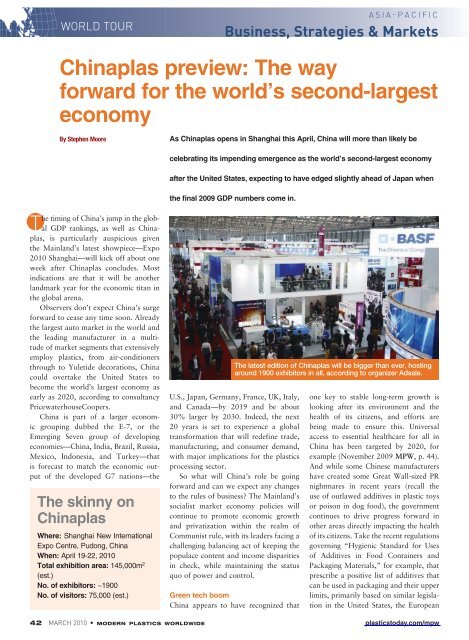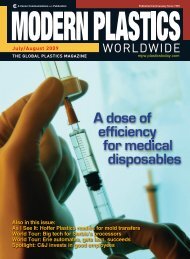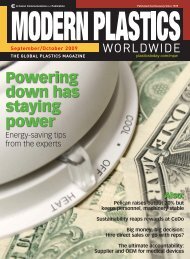Modern Plastics Worldwide - March 2010 - dae uptlax
Modern Plastics Worldwide - March 2010 - dae uptlax
Modern Plastics Worldwide - March 2010 - dae uptlax
Create successful ePaper yourself
Turn your PDF publications into a flip-book with our unique Google optimized e-Paper software.
WORLD TOUR<br />
ASIA-PACIFIC<br />
Business, Strategies & Markets<br />
Chinaplas preview: The way<br />
forward for the world’s second-largest<br />
economy<br />
By Stephen Moore<br />
The timing of China’s jump in the global<br />
GDP rankings, as well as Chinaplas,<br />
is particularly auspicious given<br />
the Mainland’s latest showpiece—Expo<br />
<strong>2010</strong> Shanghai—will kick off about one<br />
week after Chinaplas concludes. Most<br />
indications are that it will be another<br />
landmark year for the economic titan in<br />
the global arena.<br />
Observers don’t expect China’s surge<br />
forward to cease any time soon. Already<br />
the largest auto market in the world and<br />
the leading manufacturer in a multitude<br />
of market segments that extensively<br />
employ plastics, from air-conditioners<br />
through to Yuletide decorations, China<br />
could overtake the United States to<br />
become the world’s largest economy as<br />
early as 2020, according to consultancy<br />
PricewaterhouseCoopers.<br />
China is part of a larger economic<br />
grouping dubbed the E-7, or the<br />
Emerging Seven group of developing<br />
economies—China, India, Brazil, Russia,<br />
Mexico, Indonesia, and Turkey—that<br />
is forecast to match the economic output<br />
of the developed G7 nations—the<br />
The skinny on<br />
Chinaplas<br />
Where: Shanghai New International<br />
Expo Centre, Pudong, China<br />
When: April 19-22, <strong>2010</strong><br />
Total exhibition area: 145,000m 2<br />
(est.)<br />
No. of exhibitors: ~1900<br />
No. of visitors: 75,000 (est.)<br />
As Chinaplas opens in Shanghai this April, China will more than likely be<br />
celebrating its impending emergence as the world’s second-largest economy<br />
after the United States, expecting to have edged slightly ahead of Japan when<br />
the fi nal 2009 GDP numbers come in.<br />
The latest edition of Chinaplas will be bigger than ever, hosting<br />
around 1900 exhibitors in all, according to organizer Adsale.<br />
U.S., Japan, Germany, France, UK, Italy,<br />
and Canada—by 2019 and be about<br />
30% larger by 2030. Indeed, the next<br />
20 years is set to experience a global<br />
transformation that will redefine trade,<br />
manufacturing, and consumer demand,<br />
with major implications for the plastics<br />
processing sector.<br />
So what will China’s role be going<br />
forward and can we expect any changes<br />
to the rules of business? The Mainland’s<br />
socialist market economy policies will<br />
continue to promote economic growth<br />
and privatization within the realm of<br />
Communist rule, with its leaders facing a<br />
challenging balancing act of keeping the<br />
populace content and income disparities<br />
in check, while maintaining the status<br />
quo of power and control.<br />
Green tech boom<br />
China appears to have recognized that<br />
one key to stable long-term growth is<br />
looking after its environment and the<br />
health of its citizens, and efforts are<br />
being made to ensure this. Universal<br />
access to essential healthcare for all in<br />
China has been targeted by 2020, for<br />
example (November 2009 MPW, p. 44).<br />
And while some Chinese manufacturers<br />
have created some Great Wall-sized PR<br />
nightmares in recent years (recall the<br />
use of outlawed additives in plastic toys<br />
or poison in dog food), the government<br />
continues to drive progress forward in<br />
other areas directly impacting the health<br />
of its citizens. Take the recent regulations<br />
governing “Hygienic Standard for Uses<br />
of Additives in Food Containers and<br />
Packaging Materials,” for example, that<br />
prescribe a positive list of additives that<br />
can be used in packaging and their upper<br />
limits, primarily based on similar legislation<br />
in the United States, the European<br />
42 MARCH <strong>2010</strong> • MODERN PLASTICS WORLDWIDE plasticstoday.com/mpw









